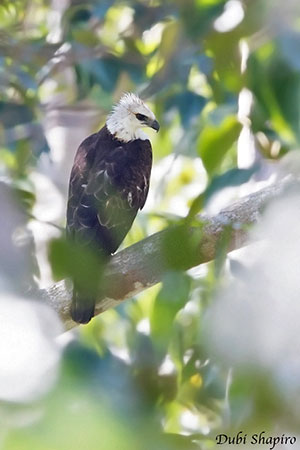
The head is white with narrow brown markings on the crown. Some longer feathers can be seen on the hindcrown.
The bill is dark grey but the cere is paler. The eyes are pale greyish. Legs are white, whereas feet are yellow with dark talons.
Male and female are similar.
The juvenile is very similar to the adults.
RANGE:
The Flores Hawk-Eagle is endemic to the Lesser Sunda Islands, and can be found on Lombok, Sumbawa, Flores and Alor.
HABITAT:
The Flores Hawk-Eagle frequents both lowland and montane forests up to 1,600 metres of elevation. It can be seen over cultivated areas, but close to native forest patches. It may sometimes hunt in forested villages or in mangroves, and also frequents parts of secondary growth and eucalypt woodland.
CALLS AND SONGS: SOUNDS BY XENO-CANTO
The voice of the Flores Hawk-Eagle is poorly known, but from an observation on Alor, this raptor gives loud, shrill, high-pitched whistle.
BEHAVIOUR IN THE WILD:
The Flores Hawk-Eagle typically feeds on small mammals, birds, lizards and occasionally snakes.
Like the closely related eagle species, it probably hunts from perch. Some observations report that this eagle sometimes hunts in villages and over cultivated areas, but it usually hunts within its forest habitat.
The Flores Hawk-Eagle probably breeds during the dry season during which some active nests are reported (but not described).
The Flores Hawk-Eagle is sedentary, but the juveniles perform some dispersal movements. This eagle is able to fly and disperse between islands within the range.
During the hottest hours of the day, it is often seen flying above the forest canopy, and it usually soars high along the steep mountain slopes.
REPRODUCTION OF THIS SPECIES:
The breeding season is suspected to take place during the dry season, from March to August. But the nesting behaviour of this eagle is poorly known.
Flight displays and copulation were observed in June-July on Flores. Nest and eggs are not described.
PROTECTION / THREATS / STATUS:
The Flores Hawk-Eagle is threatened by deforestation, persecution and capture for bird trade. The protected areas within the range are too small to ensure its long-term survival. However, a forest conservation project is running in W Flores.
The small population is estimated to number 100/240 mature individuals, equating roughly to 150/360 individuals. This population is rapidly declining within the restricted range estimated at about 40 km².
The Flores Hawk-Eagle is currently listed as Critically Endangered.
Fr: Aigle de Florès
Ang: Flores Hawk-Eagle
All: Floreshaubenadler
Esp: Águila de Flores
Ita: Aquilastore di Flores
Nd: Floreskuifarend
Sd: floreshökörn
Photographer:
Dubi Shapiro
Dubi Shapiro Photo Galleries & Dubi Shapiro's Pictures on IBC
Text by Nicole Bouglouan
Sources:
HANDBOOK OF THE BIRDS OF THE WORLD Vol 2 by Josep del Hoyo-Andrew Elliot-Jordi Sargatal - Lynx Edicions - ISBN: 8487334156
EDGE of Existence - Flores Hawk-eagle
ASAP! - Flores Hawk Eagle Nisaetus floris
ACADEMIA - Discovery of the Critically Endangered Flores Hawk Eagle on Alor island, Indonesia
The Peregrine Fund – World Centre for Birds of Prey
Global Raptor Information Network - Working to Conserve Birds of Prey in nature
The Eagle Directory - Flores Hawk Eagle - Nisaetus floris
AVIBIRDS.COM
Wikipedia, the free encyclopaedia
Flores Hawk-Eagle
Nisaetus floris
Accipitriformes Order – Accipitridae Family
INTRODUCTION:
The Flores Hawk-Eagle is a rare species found on some islands in Indonesia. It is endemic to the Lesser Sunda Islands. This species depends mainly on lowland rainforest, but it can be seen up to 1,600 metres of elevation on Flores.
Like other related eagle species, it feeds on small mammals, birds and lizards, probably caught from perches. This species breeds during the dry season.
The Flores Hawk-Eagle is heavily threatened by degradation and destruction of the habitat, but it is also affected by persecution as it often kills chickens. The species is currently listed as Critically Endangered.
DESCRIPTION OF THE BIRD:
Biometrics:
Length: 75-79 cm
This species is closely related to the Changeable Hawk-Eagle (N. cirrathus) but they differ in some morphological features.
The Flores Hawk-Eagle has dark brown upperparts. We can see white patches (sometimes greyish) at base of the upper side of inner primaries. The dark brown tail shows six blackish bars, with broader dark terminal bar. The uppertail-coverts are white.
Head and underparts are white. On the underwing, the flight-feathers are narrowly barred black. The thighs have indistinct brownish barring and streaking. The undertail is barred black and white.
